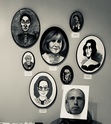What The Oscars And The Fast And The Furious Say About Institutional Racism
Last night, I bought a pint of whiskey and queued up Fast and the Furious 7 to amuse myself by live-tweeting my assessment of the Mountain Dew of movie franchises. F&F7 was an adolescent’s fantasy world, just as I assumed it would be. Just as I needed it to be. Tricked out street-racers were parachuted into a foreign country so the top-secret crime-fighting team could take down a tour bus of death. Trying to critically assess a movie that includes any one of those elements is a fool’s errand, but a movie that possesses all those elements? F&F is simply not meant to turn on your brain.
So, yeah, the movie is dumb and I was in a dumb mood so it was perfect for my needs. I was, although, struck by the progressive casting. If you are looking for racial inclusiveness, then the F&F dynasty is a much better fit than anything on the Oscar nominations list. Why is that? Why does this movie with characters as flat as a dragstrip and dialogue composed via a Mad Libs screenwriting workbook do a better job, at least on the surface, of representing the American Melting Pot?
I think the answer may be that F&F is not aimed at the artistic, intellectual elite, but rather the working class who are much more likely to be exposed to a greater array of ethnicities. This is a movie that looks like them and the people they know. This is for the multi-cultural movieplexes, not the monochromatic art house movie theaters. Yes, there is plenty of racially-based typecasting in F&F, but also an earnest attempt to put characters on equal footing regardless of ethnic background. The attempt to equalize the gender balance was a bit more clumsy, but, still, they tried.
I don’t believe it is conscious racism that induces Oscar voters to dismiss movies that reflect non-white culture. I think it is, instead, a natural aspect of being more moved by the familiar. It is easier to identify with someone who looks like you. This is why Santa Claus and Jesus will be presented differently in various cultures. The icon will reflect the people who adore it. If Oscar voters are predominately Caucasian, then they will also gravitate toward stories presenting people who look like them or the people that they know.
As a fellow artistic intellectual, I want to believe that we are above prejudice, but we are not. The Oscar nomination list is a clear example of our failure to overcome racial bias.
To encourage more multi-culturalism in Hollwood, we shouldn’t shame the members of the Academy into voting against their genuine opinions, but rather to shame the institution that does not have a voting pool more reflective of twenty-first century America. To be clear, F&F7 did not deserve an Oscar nomination unless they develop a Most Batshit Insane Stunt Of The Year category, but Chi-Raq did. Spike Lee’s adaptation of the Greek play, Lysistrata was among his most ambitious screenplays. Lee has made a name for following concepts into strange lands, regardless of how the Academy, the critics, or the general populace reacts. Chi-Raq was written in modern verse and explored the culture of gun worship within the black community with a depth, compassion, and courage I’ve not seen anywhere else in film, news media, or online. If the Academy wants to reward innovation and brave storytelling, then this movie qualifies.
So, how do we, as pretentious, artistic elites, begin to make multi-culturalism a reality rather than a vague ideal? Let me tell you a story of my own stumbling moment. I was part of a reading group a couple years back that was focused on one of the great writers of the twentieth century, Ralph Ellison. In the midst of discussions of his opus about the black experience in America, The Invisible Man, we began to consider throwing a literary festival in his honor during Black History Month. During this process, I looked across the table and had the uncomfortable realization that we were just a bunch of white guys segregated from the black community by habit.
Of course, before work began on the actual festival, we did reach out and form important relationships with leaders of the black community and the festival was a success. It has now been adopted by the Ralph Ellison Foundation and a number of important friendships were formed beyond cultural barriers in the process.
But, still, we had to decide to do it. Humans are like that. We get into our herds where we feel most comfortable and allow apathy to separate us from the rest of our beautifully diverse community. How do we start making the casts of our movies start reflecting America? Widen the scope of our herd beyond the narrow definitions of politics, religion, gender, and race. If the Fast and Furious can do it, surely the Academy can too.



